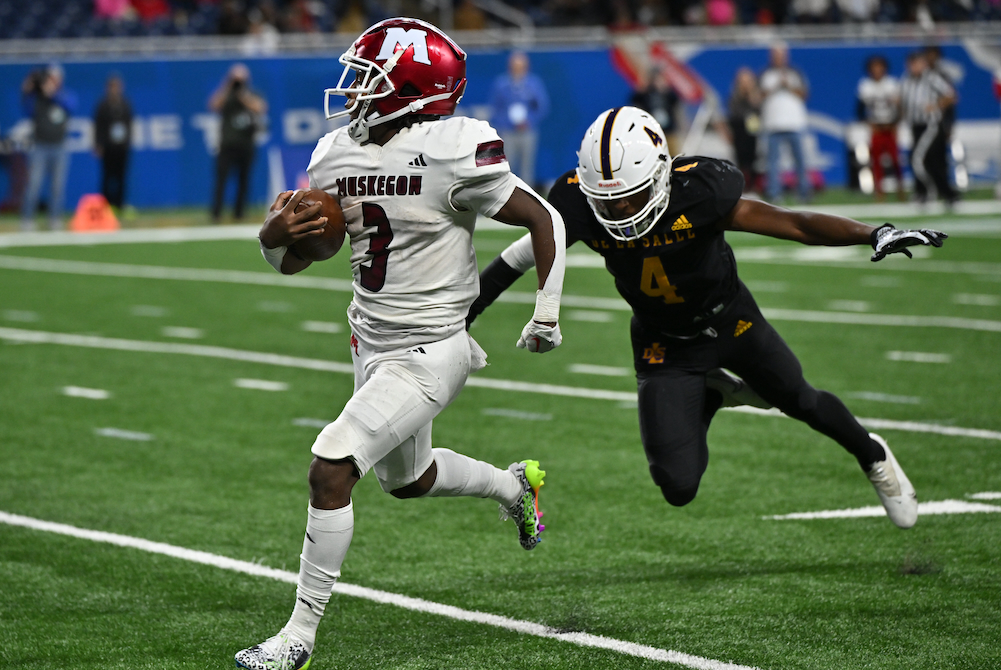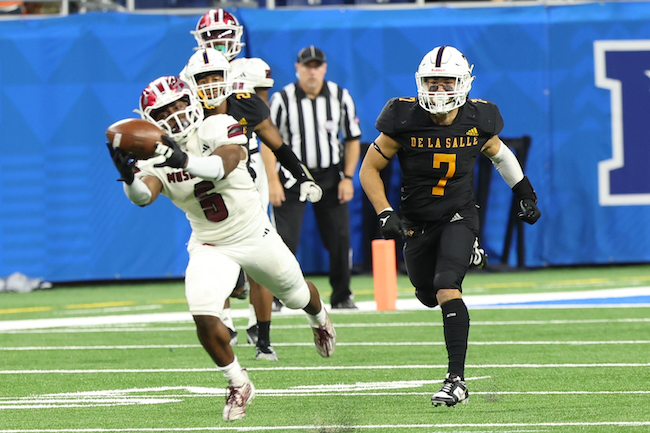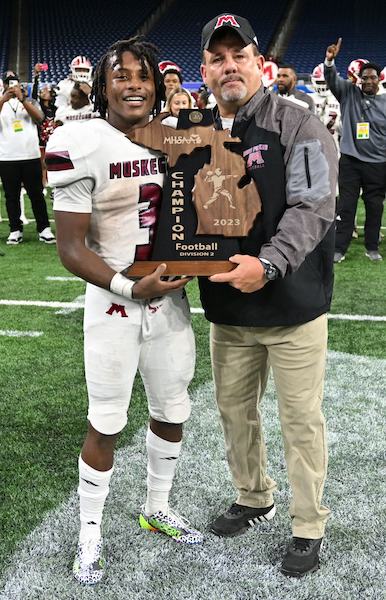
Inside Selection Sunday: Mapnalysis '13
October 28, 2013
By Geoff Kimmerly
Second Half editor
At the end of the day – Sunday, in this case – the 2013 MHSAA football playoff field was determined based on a set of numbers we began working with long before the first kickoff of this season.
So to kick off our discussion of how some of the 2013 playoff-selection decisions were made, here are a few numbers that might boggle the mind – or at least surprise:
- A total of 3,111 high school results were used in determining this season’s field – 2,978 for 11-player and 133 for 8-player games.
- We inputted and then followed the schedules for 623 MHSAA teams.
- We also inputted and followed weekly the schedules for 50 teams from surrounding states and Ontario that played at least one game against one of our MHSAA schools.
- We worked through complicated maneuverings made necessary by seven teams playing a mix of 11 and 8-player games, plus two more teams that played a mix of varsity and junior varsity opponents.
- And by Sunday morning we ended up with a few more numeric rarities: only 225 automatic qualifiers, the fewest since the current playoff system was introduced in 1999, and also an uneven number of at-large bids from our four classes because only six Class D teams reached the number of victories needed to be considered. (This was balanced by taking more at-large qualifiers from Classes A, B and C.)
And that was just the start of one of our most exciting days of the school year.
Following are more details. First, I explain some of the history of the MHSAA playoffs – I’ve lifted this in part from our 2012 report, so skip ahead if you’ve already got that down. Next, I touch on five themes that emerged as we built the brackets for this season’s tournament.
The process
Our past: The MHSAA playoff structure – with 256 teams in eight divisions, and six wins equaling an automatic berth (or five wins for teams playing eight or fewer games) – debuted in 1999, as mentioned above. An 8-player tournament was added in 2011, resulting in nine champions total when November is done.
That’s a long way from our start. The first playoffs were conducted in 1975 with four champions. Four more football classes were added in 1990 for a total of eight champions each fall. Through 1998, only 128 teams made the postseason, based on their playoff point averages within regions (four for each class) that were drawn before the beginning of the season. The drawing of Districts and Regions after the end of the regular season did not begin until the most recent playoff expansion.
In early years of the current process (or until the middle of the last decade), lines were drawn by hand. Dots representing qualifying schools were pasted on maps, one map for each division, and those maps were then covered by plastic sheets. Districts and Regionals literally were drawn with dry-erase markers.
Our present: After a late Saturday night tracking scores, we file in as the sun rises Sunday morning for a final round of gathering results we may still need (which can include making a few early a.m. calls to athletic directors). Then comes re-checking and triple-checking of enrollments, what schools played in co-ops, some records and more before the numbers are crunched and the fields are set.
Those 256 11-player teams are then split into eight equal divisions based on enrollment, and their locations are marked on digital maps that are projected on wall-size screens and then discussed by nearly half of the MHSAA staff plus a representative from the Michigan High School Football Coaches Association. Only the locations themselves are marked (by yellow dots) – not records, playoff point averages or names of the schools or towns. In fact, mentions of those are strictly prohibited. Records and playoff points are not part of the criteria. Matchups, rivalries, previous playoff pairings, etc. also DO NOT come into play. The same process is followed for organizing the 8-player bracket.
Observations and answers: 2013
This doesn’t happen overnight: Preparation for selecting the MHSAA playoff field begins long before the first kickoff of fall, much less the first practice. We load schedules for all 600-plus varsity teams during the summer, and many schedules remain fluid right up until the first Friday of the season – and this fall, a few weren’t settled until Week 2 or 3.
This summer as in some past we also worked through schools closing (Inkster, Saginaw Buena Vista, Detroit Northwestern, Flint Northern), and others deciding in mid-July and early August they would not field teams because of a lack of players.
Sometimes we have to take odd paths to find scores for these games. The last 11-player score to be added to our data this regular season came in as a result of tweeting the sports anchor of a Wheeling, W.Va., television station. Our last 8-player score came in via email from a Wisconsin athletic director at 10:30 Saturday night. Thankfully, we get plenty of assistance from some of our friends in the field, who keep an eye on the data and alert us when something appears missing or incorrect.
Win and advance: This season’s list of 5-4 teams includes a number of heavy hitters that did not receive at-large bids – East Grand Rapids, Utica Eisenhower, Orchard Lake St. Mary’s and Flint Powers Catholic to name a few. All were solid teams and played strong competition. All missing the playoffs likely raised some eyebrows.
But we have to take a look at this from a statewide view. There admittedly can be some argument about what schools qualified for the 226-256 spots in the field – but the important part is that 225 qualified because they all met the minimum win requirement. A playoff is simply that – it decides a champion based on teams winning. For some it’s harder to pile wins, of course, because they play in tough leagues. But the winners of those leagues are in the field – and surely will credit that tough road with getting them prepared to now play the state’s best.
Geography rules: This long has been rule number one for drawing MHSAA brackets in any sport, and is a repeat as well for those who have read this report the last two Octobers. Travel distance and ease DO come into play. Jumping on a major highway clearly is easier than driving across county-wide back roads, and that’s taken into consideration.
Also, remember there’s only one Mackinac Bridge and hence only one way to cross between peninsulas – and boats are not considered a possible form of transportation. When opponents from both peninsulas will be in the same District, distance to the bridge is far more important than as the crow flies.
The best example of this comes this season in Division 5. Grayling clearly is east of both Kingsley and Kalkaska – but also sits on I-75, while those two do not. So while those more western teams are geographically closer to Houghton, Menominee and Kingsford from the Upper Peninsula, we instead paired the three U.P. teams with Grayling because being on a main highway made for a shorter trip. The trip to Grayling for any of those U.P. teams would be 36 miles shorter to Grayling than Kingsley and 13 miles shorter to Grayling than Kalkaska.
Sometimes it’s where the points aren’t: Sure, it would be best-case scenario to have perfect sets of eight dots split into four quadrants from Calumet to Bedford. But generally that doesn’t occur. “Dots determine the map” is a common phrase heard here during this selection process, but that works the other way as well. If there are no qualifiers in a division from a specific area of the state – see Division 1, with none south of Holland or west of the greater Lansing area – there’s no choice but to create the unusual Regional Final possibility of Traverse City West vs. Brighton. Brighton is simply closer to the west side of the state than our other options.
Border to border vs. coast to coast: Should Regions be grouped north to south or east to west? There isn't a right or wrong answer – it just depends on that set of dots.
Whenever we have Upper Peninsula teams in a division, they’ll be grouped with those from the northernmost points of the Lower Peninsula for a District. The next northernmost schools will be grouped into a District, and together those eight will form a Region.
But the tough decision comes with the other six Districts. Look at this season’s Division 5 map: Six Districts are grouped south of U.S. 10 with three near or west of U.S. 127 and three east of that highway, which runs through the center of the Lower Peninsula. We grouped the two southwestern Districts into a Region and the two southeastern Districts into a Region – leaving a final Region that stretches from Muskegon on Lake Michigan to Almont, about 35 miles west of Lake Huron.
That’s a haul. But it’s also the best of our possible compromises. We could’ve instead paired regions that would’ve stretched from Hopkins to Monroe – only 19 fewer miles in distance than Muskegon Oakridge to Almont, but a scenario that could’ve created travel increases for a number of additional teams. Another option included a possible trip from Detroit University Prep to Freeland, which also would take more than two hours.
Bottom line – it’s been written here before – we pour all we have into this process, asking questions often more than once until we come up with a consensus. We do appreciate the arguments that arise once brackets are released to the public: The discussions are proof of how much players, coaches and fans care – and often show us new ways we can look at a system that’s now 15 years old.
But we must remember that the good news is the tournament is still set up to reward nine champions over the next five weeks, and five schools – Auburn Hills Oakland Christian, Coldwater, Detroit Allen, Eaton Rapids and Muskegon Mona Shores – will be competing for those titles for the first time.
It’s not so much how the tournament starts as how it ends. And we’re preparing for nine more memorable conclusions.
PHOTO: Each collection of grouped dots is a District on this season's Division 3 playoff map.

Guy Delivers Champion's Trophy This Time After Sparking Muskegon's Comeback Win
By
Paul Costanzo
Special for MHSAA.com
November 26, 2023
DETROIT – M’Khi Guy was going to get his hands on the championship trophy no matter what happened in Saturday night’s Division 2 Football Final.
Handing out the championship and runner-up trophies is one of the perks of being part of the MHSAA Student Advisory Council, of which the Muskegon senior is a member. As much of an honor it would have been either way, Guy wanted to do everything he could to make sure he was handing the bigger wooden mitten to his coach, Shane Fairfield.
After rushing for 215 yards, throwing for 159 and accounting for four touchdowns, Guy got to do just that, placing the Division 2 championship trophy into Fairfield’s hands following Muskegon’s 33-21 victory over Warren De La Salle Collegiate at Ford Field.
“It’s awesome,” Guy said. “Last year wasn’t too fun for me, because I had to give it to the opposing team, Detroit (Martin Luther) King. But this time, I got to give it to my coach, my guy right here, and it made me feel great.”
Muskegon prevented De La Salle from winning a third straight Division 2 title while claiming its seventh Finals championship. It was the first since winning it all in 2017, and in between then and now Muskegon had finished runner-up three times, including a year ago to King.
 “Everyone was wanting us to give up and quit and not get here,” Fairfield said. “‘You’re going to lose when you get there.’ And, like I said before we left, people want us to fall apart, people want us to break. I said we will not be broken today. We keep telling these guys to follow us and trust us. As much as they get the naysay, for these young men to believe in this coaching staff and their school district, in each other – words do not describe it.”
“Everyone was wanting us to give up and quit and not get here,” Fairfield said. “‘You’re going to lose when you get there.’ And, like I said before we left, people want us to fall apart, people want us to break. I said we will not be broken today. We keep telling these guys to follow us and trust us. As much as they get the naysay, for these young men to believe in this coaching staff and their school district, in each other – words do not describe it.”
Muskegon (13-2) had to muster up some extra belief at halftime as it was down 21-7, and outside of an 80-yard touchdown run by Guy had gotten next to nothing going on offense.
That changed almost immediately in the second half, as Guy ran for a 52-yard score on the first possession of the half, and Muskegon wound up out-scoring the Pilots 26-0 over the final 24 minutes.
“They made plays and we didn’t,” De La Salle coach Dan Rohn said. “We went out there on that first drive and went three and out and gave them the opportunity to have the field. Then we did pin them deep, they hit us with a 90-yard touchdown pass, which is what we want them to do is throw the ball. Then we get an opportunity to get a drive going, we drop a pass, we have a fumble – uncharacteristic of us. We didn’t make those plays in the second half; they did.”
The 94-yard touchdown pass was what tied the game up, as Guy hit Destin Piggee down the middle of the field. Piggee had broken open, and Guy lofted the ball for him to run under. Piggee accelerated toward the ball, somehow kept his feet at midfield, and ran the rest of the way for the score, turning the game on its head midway through the third quarter.
“Really, at first I thought it was overthrown, so I was thinking I was going to dive for it,” Piggee said. “But I was able to keep my ground. As I was running, I was looking up at the screen and I saw (De La Salle defensive back James Wallace) gaining ground on me, so I swerved to the left a little bit and just kept on running.”
 The Big Reds didn’t take their first lead of the game until the 2:16 mark of the third quarter, when Guy hit Da’Carion Taylor for a 28-yard score, making it 27-21.
The Big Reds didn’t take their first lead of the game until the 2:16 mark of the third quarter, when Guy hit Da’Carion Taylor for a 28-yard score, making it 27-21.
Taylor had set the drive up with a fumble recovery in Muskegon territory and was tended to for an injury afterward. He returned, however, to make the leaping grab in the end zone.
A 12-yard TD run by Jakob Price gave the Big Reds a two-score lead at 33-21 with 10:43 remaining, but it was a later drive that didn’t provide any points that essentially put the game away.
After forcing a turnover on downs at their own 20, Muskegon drove 61 yards on 11 plays, taking 6:36 off the clock. While the score remained 33-21 when the drive ended, De La Salle was left with just 1:26 to score twice.
Even with that, though, Fairfield wasn’t satisfied until the final seconds ticked off the clock.
“When there was 11 seconds on the clock, I still wasn’t ready,” Fairfield said. “I’ve been here before. We were four seconds away from beating (Orchard Lake) St. Mary’s in (2016), and they threw a Hail Mary pass. I was re-living that again.”
Price finished with 86 yards rushing and the one touchdown for Muskegon.
De La Salle was led by Sante Gasperoni’s 249 yards passing and 41 rushing. He had two touchdowns on the ground, and one through the air to Damion King IV. King finished the game with 103 yards on five catches for the Pilots (12-3).
PHOTOS (Top) Muskegon’s M’Khi Guy (3) pulls away on one of his long runs during Saturday’s Division 2 Final at Ford Field. (Middle) The Big Reds’ Destin Piggee (5) stretches to snag the ball on his 94-yard touchdown catch. (Below) Guy presents the championship trophy to his coach Shane Fairfield as part of his duties as a member of the MHSAA Student Advisory Council. (Photos by Hockey Weekly Action Photos.)

